Buenos días, Spanish readers!
Bonjour to our French readers.
Ohayō gozaimasu to our Japanese readers.
These are a few different ways to say good morning in other languages. But even in English, we have many options for greetings.
We say “good morning” almost without thinking, don’t we?
It’s like breathing. Automatic and effortless.
But when you mix up and try to be different in your morning greetings, you look more professional, people like you more, and make boring mornings way more fun.
Your greetings actually depend on who you’re talking to.
While addressing your boss, you might want to sound professional and respectful. With your best friend, you can be silly or cute instead.
It all depends on your relationship and the context—whether it’s work emails, social media comments, private messages, or face-to-face conversations.
In this blog, we’re going to explore the different ways to say good morning—from cute to professional, playful to multilingual—and when each one makes sense.
Plus, we’ll show you how AI tools can help you find the right tone when it counts most.
Let’s dive in.
Professional Alternatives to “Good Morning”
Sometimes, “Good morning” feels… boring.
It’s safe. It’s polite. But when everyone uses it all the time—from emails to meetings—it starts to feel very repetitive.
So what are some other ways to say good morning that still feel thoughtful, professional, and warm?
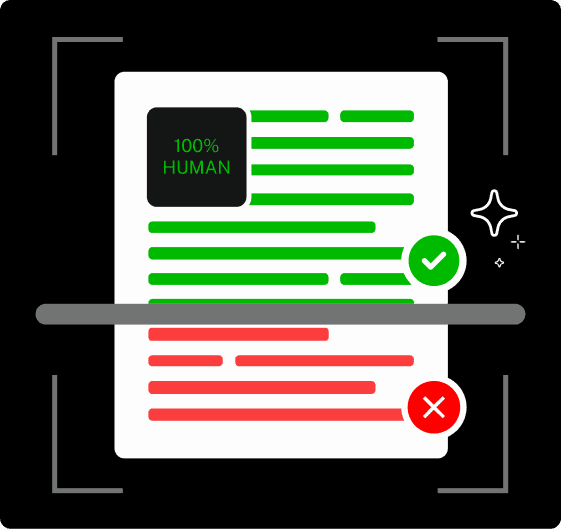

Never Worry About AI Detecting Your Texts Again. Undetectable AI Can Help You:
- Make your AI assisted writing appear human-like.
- Bypass all major AI detection tools with just one click.
- Use AI safely and confidently in school and work.
That’s where formal greetings come in.
A formal greeting is how you say hello in a way that shows respect, confidence, and readiness.
It’s not just what you say—it’s how you say it. It could be:
- A line at the start of an email.
→ Example: “Good morning, Mr. Thomas. I’ve attached the report for today’s review.”
- A few words before a meeting begins.
→ Example: “Hello everyone. Thanks for being here—let’s get started.”
- A smile and a nod in person.
- Or even how you show up—shirt tucked in, notes ready, on time.
All of these things send one clear message: “I respect your time. I’m ready to work.”
Let’s look at how these greetings are built…
Most professional greetings follow this simple formula:
Friendly opener + Purpose or wish
For example,
- Good morning, Jordan. I hope your week is off to a smooth start.
- Hello team. Let’s jump into today’s goals.
- Greetings! Ready to kick off our Q2 review?
These are still kind. Still professional. But they go one step further than just “Good morning.”
And every industry has its own style.
If you work in a law firm or government office, your greeting should sound more formal:
- Example: “Good morning, Ms. Carter. I’ve attached the updated documents for your review.”
But if you’re in a more relaxed workplace, like a startup or creative agency, you can sound a little more casual:
- Example: “Hey Jordan! Hope you’re ready to crush that pitch today.”
Same idea—just matched to the tone of your workplace.
But we don’t have to come up with professional alternatives all by ourselves. Let’s see how Undetectable AI Chat can help. Just open the chat and type:
“Give me a professional greeting for a strict boss.”
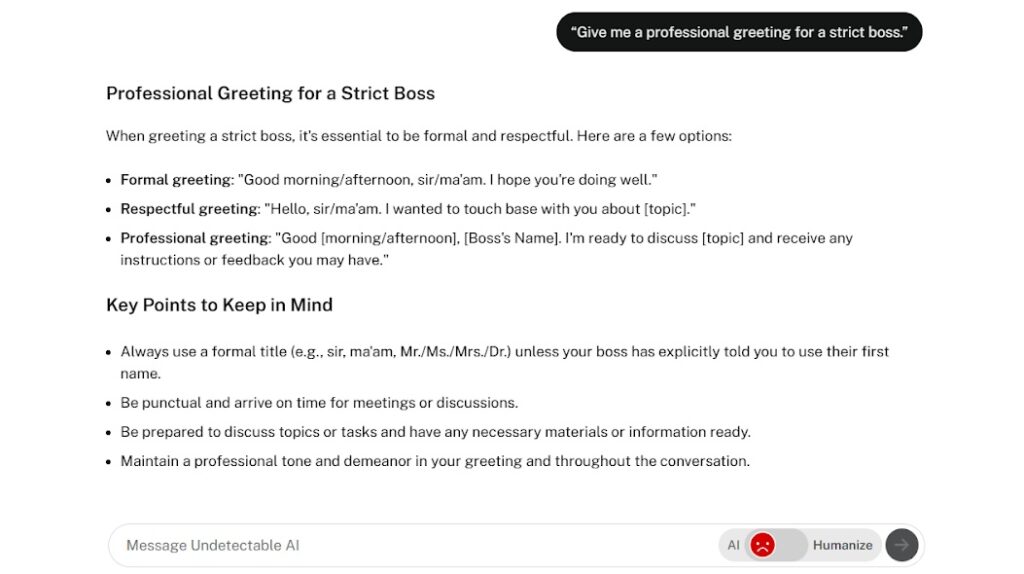
Similarly, you can try different prompts, and AI Chat will give you a list of professional greetings along with the specific points to keep in mind.
Casual and Friendly Greetings
Looking for other ways to say good morning in casual settings?
You don’t always need to sound buttoned-up—especially if you’re chatting on Slack, leaving a LinkedIn comment, or sending a quick message to a work friend.
In these moments, saying something formal like “Greetings, Jonathan. I hope you’re well” would just feel… weird. (And Jonathan might even tease you for it.)
Instead, you can use casual greetings to keep it light and real.
For example, here are some casual greetings you can use:
1 – For Close Colleagues:
- Hey hey, ready to roll?
- Morning, team! Let’s do this.
- You made it! Let’s crush this day.
- Wakey wakey, coffee’s calling.
- Rise and shine, legends.
2 – For Work Friends:
- What’s up, sleepyhead?
- Morning, sunshine
- Let’s pretend we love Mondays.
- You alive yet or still dreaming?
- Ready to survive another meeting?
3 – For Social Settings (like LinkedIn):
- Happy Monday, folks!
- Cheers to a brand-new week.
- Let’s make today count.
- Sending good vibes this morning.
- Morning crew, who’s bringing the coffee?
These greetings feel different from the usual. They’re more relaxed. They help build friendship and trust with people you already know.
And yes—grammar sounds different in casual greetings too. You might use contractions like:
- “Mornin’” instead of “Good morning”
- “What’s up” instead of “How are you”
- And maybe an emoji or two to show tone (just don’t overdo it).
Let’s see how AI Chat can help. Try this prompt:
“Fun ways to say good morning to my remote team.”
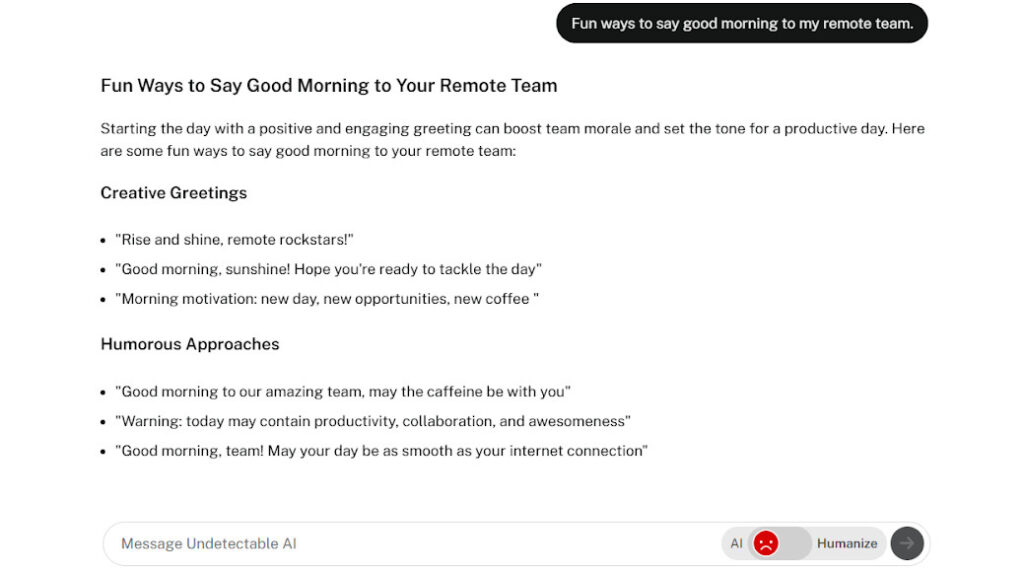
Try different prompts, and you’ll get a bunch of fresh, fun ideas.
Funny and Playful Ways to Say Good Morning
Some mornings are way too serious. Everyone’s quiet. No one wants to be at their desk. You can feel the yawns in the air.
That’s when you can use funny and playful ways to say good morning to break the silence.
But… Here’s the thing.
Not every joke lands.
Humor is tricky. What’s funny to one person might be weird or even rude to another.
So always think: Who am I talking to?
- Your work bestie? Go for it.
- Your boss’s boss? Maybe stick with polite.
Now—some ideas to play with:
Examples:
1 – Joke-Based Greetings
- Good morning! My coffee’s doing the talking today.
- Hello! I woke up five minutes ago, but I’m here.
- Morning! If I yawn too loud, just ignore me.
2 – Pun-Based Greetings
- Time to espresso ourselves.
- Have an egg-cellent morning!
- Lettuce have a great day.
3 – Meme & Pop Culture-Inspired
- It’s giving… barely awake.
- This meeting could’ve been an email—but hi!
- I volunteer as tribute… for more sleep. (Hunger Games)
4 – Situational Humor
- On a deadline day: Morning! May the odds be ever in our favor.
- After a team party: Hi. I am 90% coffee, 10% regret.
- After tech issues: Morning! If Zoom crashes, I was never here.
You see the pattern? It’s fun, but still human.
Now we’ll see how we can use AI Chat to help us. Let’s try this prompt:
Funny morning greetings for a team Slack channel.
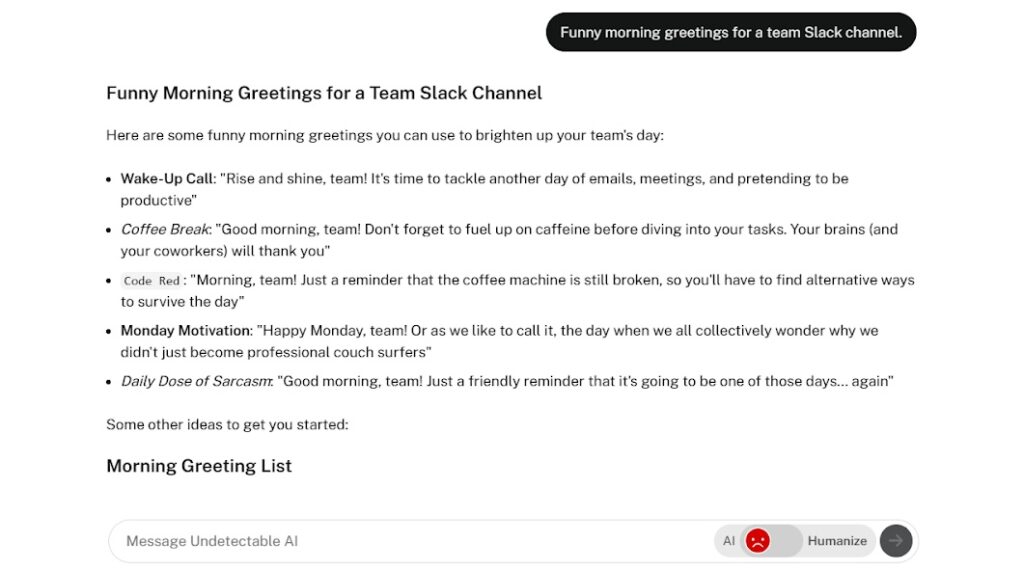
You’ll get fun, fast ideas that can bring smiles without crossing the line.
Cute Ways to Say Good Morning
You might use cute greetings in a text to someone you love, or message to your best friend, or even in a sweet Instagram comment.
For example, here are the cute ways to say good morning.
- Texting your bestie: Rise and sparkle, sunshine!
- DMing your partner: Good morning, my favorite human.
- Commenting on a friend’s Instagram: Hello, beautiful! Crush today.
- To your sibling: Wakey wakey, eggs and bakey!
See the difference? These greetings feel light, kind, and a little silly in the best way.
A lot of cute greetings use small word tricks, too. For example,
- Add diminutives—words that end in -ie or -y to sound softer:
- Sweetie
- Hunny
- Cutie
- Use nature metaphors.
- Hello, little sunflower!
- Pair with emojis.
- Morning, sleepyhead 😴→☀️
Remember that cute greetings only work when you know the person well. Don’t send “Good morning, baby” to a coworker unless you want HR involved.
Want help coming up with a cute message for someone special?
Try asking AI Chat
What’s a cute good morning message for my partner who loves coffee and bad puns?
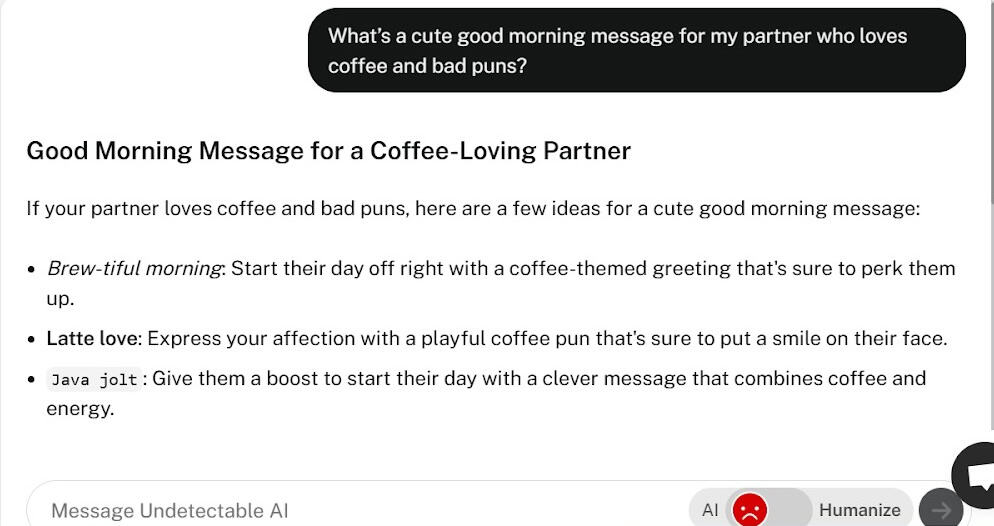
You’ll get some cute ideas to say good morning.
Multilingual or Cultural Variations
Let’s pretend you’re at a café in Paris. You smile at the waiter and say “Bonjour!” instead of “good morning.”
Suddenly, their faces light up. And for that to happen, you need to know how to say good morning in different languages.
Here are some popular ways to say “Good morning” in different parts of the world:
- Spanish: Buenos días (bweh-nos DEE-ahs)
- French: Bonjour (bohn-ZHOOR)
- Japanese: Ohayō gozaimasu (oh-ha-YOH go-zai-mass)
- Arabic: Sabah al-khayr (sa-BAH al-KHAIR)
- Hindi: Suprabhat (soo-prah-BHAAT)
- Swahili: Habari za asubuhi (ha-BAH-ree za ah-soo-BOO-hee)
In many languages, there’s a formal and informal way to say things.
For example:
- In Japanese, Ohayō is for friends. But Ohayō gozaimasu is for your teacher or boss.
- In Arabic, people often respond to Sabah al-khayr with Sabah al-noor, which means “morning of light.”
And there are different tones as well. To make sure that you’re not sounding like a robot, you can take help from AI Chat.
Open AI Chat and type:
Translate ‘Good morning’ into 10 languages, and tell me how to use them politely.
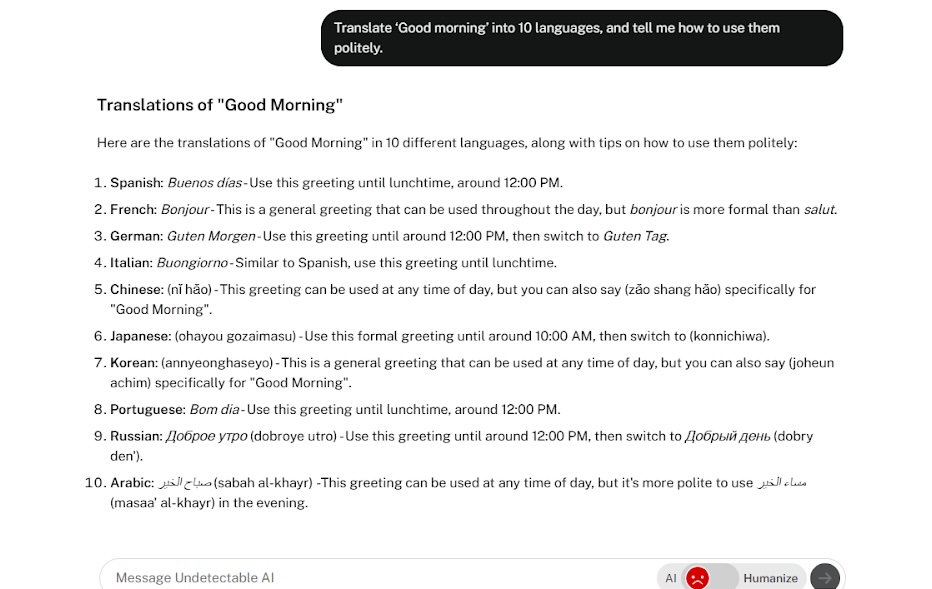
You’ll not only learn the words—but how to say them right.
When to Stick With “Good Morning”
Sometimes, you don’t need to be funny or cute. Sometimes, “Good morning” is exactly right.
Imagine you’re in a job interview. Your palms are sweaty. The hiring manager says, “How would you start an email to a client?”
You could say, “Hey there, sunshine!”
But you should say, “Good morning, [Name].”
Why?
Because safe = smart here.
You should use traditional greeting style:
- In a job interview.
- While talking to a new client.
- Writing your resume or cover letter.
- Cold emailing someone for the first time.
These are the moments where the professional wins. You don’t want to sound silly. Or too casual.
You want to sound like you respect their time and take things seriously.
That’s why “Good morning” works so well. It’s neutral. It’s safe. It’s clear.
And honestly? It shows that you know the rules.
Now, if you’re applying for jobs and wondering what to say in your messages or emails—we’ve got tools for that.
1 – Resume Builder
Building a great resume used to take days.
You’d sift through keywords, compare templates, study winning resumes—and even then, you’d still wonder if it’s good enough.
Those days are gone.
This AI-powered Resume Builder simplifies the whole process. Just choose a template that fits your industry and let our smart system do the heavy lifting.
It’s designed to:
- Integrate ATS-friendly keywords so your resume gets past filters.
- Sound authentic and human (thanks to AI Humanizer tech).
- Let you save multiple versions tailored for different roles.
In three steps, you’re ready to go:
- Pick a template that matches your career goals.
- Customize with AI suggestions that highlight your strengths.
- Download and apply to jobs with confidence.
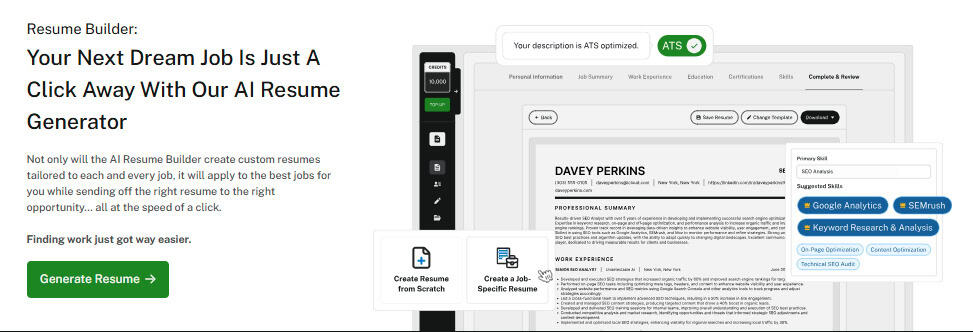
Want to go even faster? Pair it with our AI Job Application tool.
2 – AI Smart Applier
>> Try AI Job Application Tool Here
AI Smart Applier applies to dozens of jobs in a week while you sleep. It’s your personal job-hunting assistant, built with automation in mind.
No freelancers. No spreadsheets. No burnout.
Here’s what it does:
- Connects with your LinkedIn to find the best-fit jobs.
- Personalizes every application to match the role
- Applies automatically while you focus on what matters
- Sends real-time updates, so you never miss a beat
To get started:
- Upload your resume and connect LinkedIn.
- Set your job search filters to match your ideal role.
- Let it auto-apply to the best jobs, hands-free.

3 – Cover Letter Generator
>> Try Cover Letter Generator Here
You don’t need to open six different tabs to write a perfect, personalized cover letter.
This cover letter generator is trained on proven, high-performing examples and helps you create tailored cover letters every time.
Here’s how it works:
- Get started with one click.
- Enter your info or import your LinkedIn profile.
- Customize and download your cover letter, ready to go.

You get professional, HR-approved letters that actually get read.
It’s fast, effective, and tailored to your industry.
Start exploring—our AI Detector and Humanizer are waiting in the widget below!
FAQs: Morning Greetings
Is it okay to say “Morning” instead of “Good morning”?
Yes, “Morning” is perfectly fine in casual or informal settings.
However, avoid using it in formal writing, professional emails, or when making a first impression.
In those cases, stick with “Good morning” to maintain a more respectful tone.
How do you say good morning professionally in an email?
For a professional email greeting, try: “Good morning, I hope this message finds you well,” or “Good morning, [Name]. I wanted to follow up on…” Another option is, “Good morning, and thank you for your time.”
Can I use emojis in a morning greeting?
Yes—but use them selectively. Just be sure they align with your company culture.
For external clients, senior leaders, or formal communication, avoid emojis unless you’re sure it’s acceptable.
Final Thoughts
The words we choose first thing in the morning matter more than we think.
They set the tone. They build relationships. They can turn an ordinary day into something special.
Think about it… how do you feel when someone greets you with genuine enthusiasm versus a mumbled “morning”?
Different, right?
So this mean that you should overthink every morning greeting? No.
Should you be more intentional about how you greet people? Absolutely.
What’s the easiest way to improve your morning communication?
Start by noticing how different greetings make you feel when you receive them. Pay attention. Listen. Then adjust your own greetings accordingly.
Morning greetings are more than pleasantries – they’re opportunities.
Opportunities to show care, to demonstrate respect, to spread a little joy, and to connect on a human level before diving into the day’s tasks.
Good morning. Buenos días. Bonjour. Ohayō gozaimasu.
Whatever words you choose, say them like they matter – because they do.
